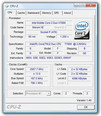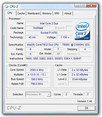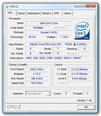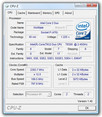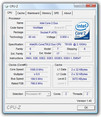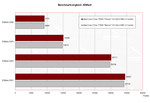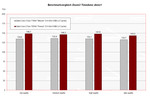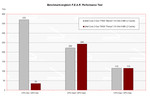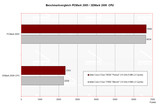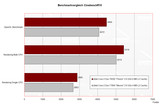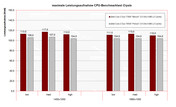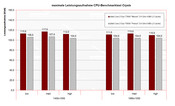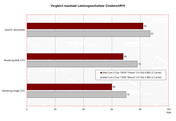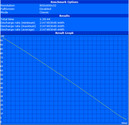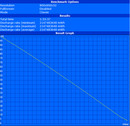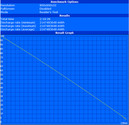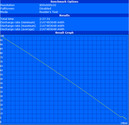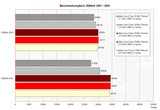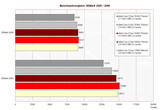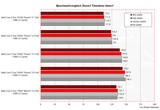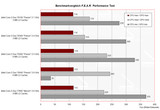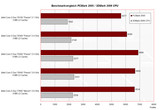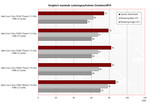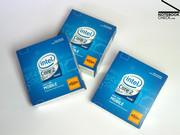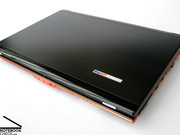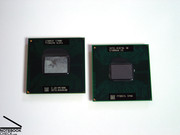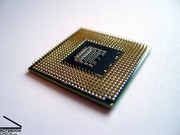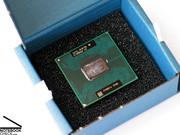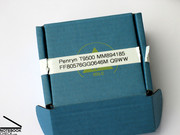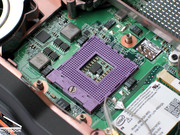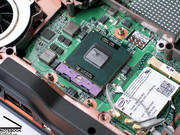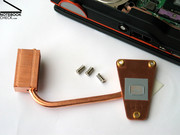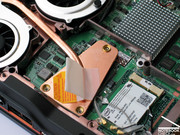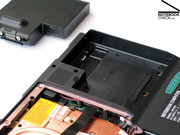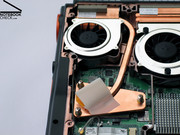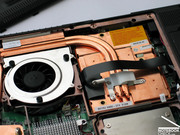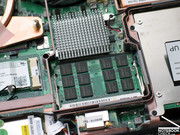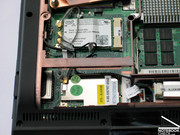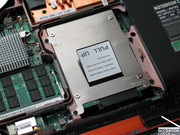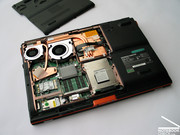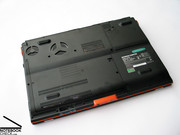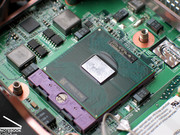Review Intel Core 2 Duo „Penryn“ CPUs
Small, undemanding, but, powerful. This would be a suitable short description of the new mobile Penryn CPU by Intel. The main advantages of the new processor besides switching to 45nm production, which allowed a dramatically higher number of transistors, are a larger L2-cache and improved energy saving functions.
Introduction
The new Penryn notebook processor generation was introduced at the same time as their desktop counterpart. Produced in 45nm (nanometer), the Penryn core is considerable smaller than it's Merom equivalent, but manages to pack many more transistors on its reduced available surface. Expressed in numbers, this means a transistor increase from 291 million on the Merom core, to 410 million on the new Penryn processor. This is an increase of more than 40%.
Another important change is the enlargement of the L2-cache by 50% compared with Merom processors. This means a L2-cache of 3 respectively 6 megabytes. Since this increases the amount of data available for quick processing by the CPU, it is probably the most important advantage of the Penryn architecture for most users and mainly responsible for the measured performance improvement. The clock rate of the new Penryn cores on the other hand, stays currently with maximal 2.6GHz at a similar level as the Merom models.
| Type | Clock Rate | L2-Cache | TDP | Price |
| X9000 | 2.8 GHz | 6MB | 44 Watt | $ 851.- |
| T9500 | 2.6 GHz | 6MB | 35 Watt | $ 530.- |
| T9300 | 2.5 GHz | 6MB | 35 Watt | $ 316.- |
| T8300 | 2.4 GHz | 3MB | 35 Watt | $ 241.- |
| T8100 | 2.1 GHz | 3MB | 35 Watt | $ 209.- |
Regarding their TDP values (Thermal Design Power) the new Penryn models don't differ from their Merom counterparts. T9xxx and T8xxx models are currently listed with 35 watt. The extreme version called X9xxx needs cooling power of 44 watt. Manufactures should thus be able to fit the new processors into notebook models with corresponding Merom CPUs, at least considering the cooling needed.
Although replacing existing Merom CPUs in notebooks with Penryn processors is possible, it is only of limited use according to Intel, because the new processors require BIOS support and hardware compatibility of the mainboard in order to achieve full performance.
T7800 Merom vs. T9500 Penryn
The following questions seem to be the most important for a potential notebook buyer:
What are the advantages of the new Penryn processors and how much do they cost?
Intel has of course an answer for those questions. The official press release of 7th of January 2008 says:
„All of these new chips (...) boost a PC's speed, reduces power requirements, saves on battery life, helps the environment and comes in smaller packages for more fashionable and compact computer designs. ...".
This sounds good as usual. The price of the new chips should be on a similar level as the Merom processors as well. More performance for the same price - If one believes Intel's statement, the old models are pretty much obsolete now. But how well do Penryn CPUs actually do in practical tests?
With support from Schenker Notebook, which offered us not only a mySN M570RU gaming notebook, but also the complete Penryn CPU lineup, we had the possibility to compare the processors directly with each other, respectively with the "old" T7800 Merom core.
Due to the specifications of the test sample with nVIDIA Geforce 8800M GTX graphic, the main focus was on game performance tests as well as various application benchmarks.
Gaming Benchmarks
Only very minor performance differences between the T9500 Penryn and the T7800 Merom CPU were noticeable while running the well known 3DMark benchmark test. The Penryn was ahead in all tests, but, the differences were rather small, just about a digit of the percentage. A reduction of the Penryn bonus was also noticeable with newer 3DMark versions, especially 3DMark 2006. This is due to higher demand for graphics power in current benchmark tests.
The difference in performance was a bit clearer while running the Ego-shooter Doom3. Although the performance differences in this test get smaller the higher the graphic settings as well, performance differences of up to 10% between the Penryn and Merom processor could be observed. This proves that processor performance makes especially a difference in older games, where the graphics card isn't the limiting factor.
The benchmark test of the DirectX9 horror shooter F.E.A.R. follows up on the observations so far. If one ignores the poor result with GPU min / CPU min settings of the Penryn, which is apparently a driver related problem, it manages a slight lead in medium settings which turns into a tie on maximal GPU and CPU settings. Like in the tests before, the graphics card becomes the limiting factor at higher graphic settings, which makes processor performance less relevant.
The real time strategy game World in Conflict was tested with medium details (DirectX9) as well as high details (DirectX10). In both settings slight advantages of the Penryn processor were detectable. However, the differences were low single digit percentages once again.
The most important of the current gaming tests is of course Crysis, another ego-shooter made by EA-Games. The fact that Crysis is very demanding regarding graphic performance and doesen't like cards which are slower than a 8800M GTX, should be well known by now. But we are more interested in how much of an influence the CPU has on the benchmark results.
Once again the conclusion is that the results of the Penryn and Merom processor become more similar, the higher the graphic detail level. This phenomenon is noticeable independently of the resolution. The Penryn processor doesen't really make a difference during normal game play on medium settings (not even the Geforce 8800M GTX manages playable frame rates with high details). The observed results are virtually identical.
Clearly noticeable, and thus for the user more relevant, were the differences in the benchmark tests with Cinebench Release10. In all test categories, starting with Single and Multi CPU rendering to OpenGL benchmark, the Penryn processor manages an up to 10% better performance.
Power consumption
According to Intel, an advantage of the Penryn processor is the noticeable reduced energy consumption, which is especially important for notebooks. The fact that other system components have a rather big influence on energy consumption as well, makes an objective comparison difficult. The following values should, therefore, be interpreted as reference values, which show a trend nonetheless.
The observed power consumption during the Cinebench R10 benchmark verifies Intel's statement and shows an approximately 10% lower maximal power consumption of the Penryn processor in all tests.
The difference in the Crysis CPU benchmark test is lower but the Penryn still manages to reduce the power consumption noticeable.
Battery life time
Like power consumption, battery life time of the mySN M570RU test samples with T7800 respectively T9500 processor is affected by other hardware components, results should thus be taken with a grain of salt.
Anyway, the Penryn system managed a 4 minutes longer battery lifetime over the total duration of 90 minutes in the Classic Test (Last) of the software tool Batteryeater. In the Readers test (simulation of reading text with lowest brightness), the Penryn configuration led by 9 minutes (total life time 148 minutes).
The saving potential of the Penryn processor would probably be higher with office hardware or a modest equipped multimedia notebook, considering the complete system. But for concrete results we'll have to wait for first tests of such mobile systems to appear.
Current Penryn processor in comparison
The T9500 Penryn processor is usually ahead of the T7800 with identical clock rate. Depending on usage however, differences can be more or less distinctive.
Since both CPUs sell currently at the same price, the number of Penryn processors is expected to grow quickly.
The Penryn lineup consists currently of four models with 3 respectively 6MB L2-cache and a clock rate of 2.1 to 2.6 GHz, as well as an extreme version with 2.8GHz. The following test will show how well each of them does if pitted against each other.
Gaming Benchmarks
We start our comparison once more with the widely known Futuremark 3DMark benchmark test. During the tests 2001 to 2006 a tie between T9300 and T9500 processors becomes apparent. Both are slightly faster or equal to the T7800 CPU. Also noticeable once more, is the decreasing influence of the processor on the result with newer 3DMarks, especially 3DMark 2006.
Both Penryn top versions manage a lead over the Merom CPU with 2.6GHz in the Doom3 Timedemo benchmark test as well. A bit behind are the T8xxx versions with 3MB L2-cache each.
The F.E.A.R. benchmark test shows similar results with medium CPU and GPU settings, though the Merom processor is still faster with minimal CPU and GPU settings. We failed to find out why the T9500 processor did so poorly. The phenomenon appeared in each of the several benchmark tests (including restart). All processor models showed the same results in maximal CPU and GPU settings. The graphics card plays an important role here once more.
The World in Conflict performance test shows a noticeable lead of the 6MB L2-cache CPUs of up to 10% on medium as well as high details in all tests. Only in the highest possible resolution on our test system of 1680x1050 and high details, show all processors virtually identical frame rates.
Similar results appeared during the Crysis benchmark test. While running the CPU benchmark test at different resolutions, a noticeable lead of the T9300 and T9500 CPUs emerges at low details, which decreases the higher the details and finally becomes non existent at high details. This phenomenon can already be observed at medium details if the resolution is 1400x1050 or higher. The CPU benchmark results show an identical result.
Recommended for gaming purposes are therefore especially the two Penryn models with 6MB L2-cache, which were always slightly ahead in our tests. The T9300 2.5GHz processor is probably the most attractive, if one considers the price as well, since it is currently about 200 dollar cheaper than the T9500 model while offering similar performance.
Application benchmarks
Surprisingly, the T9300 CPU takes the lead in the PCMark 2005 benchmark comparison. Following the T9500 and T9300 processors are again the Merom CPUs. Slightly behind are the two 3MB L2-cache models of the T8300 and T8100.
Even clearer is the superiority of the Penryn CPUs in the Cinebench R10 benchmark test. While the two 6MB cache CPUs T9500 and T9300 clearly lead the field again, even the T8300 CPU with 3MB L2-cache and 2.4GHz manages to get close to the T7800 Merom processor with 2.6GHz and 4MB L2-cache.
Power consumption
If one observes the maximum power consumption of the Penryn CPUs during the Cinebench R10 benchmark, a clear improvement becomes apparent compared with the Merom comparison processor. However, the differences among the three Penryn CPUs is rather small, apart from the T8100 with 2.1GHz which has an approximately 10% lower power consumption than the T9500 CPU.
Verdict
The new Intel Core 2 Duo Penryn models offer a variety of changes like the enlargement of the L2-cache by 50%, new energy saving functions and SSE2 commands. The summarised practical use for the user is increased performance and lower power consumption.
Although the advantages of the Penryn CPU are rather limited, especially for current games which profit far more from a more powerful graphics card, it is still an improvement over the Merom processor and, most important for the notebook buyer, at an identical price.
The strengths of the new processors should become especially apparent with CPU demanding office applications (rendering, decoding,...). Regarding the lower power consumption (minus 10% under maximum load!) the Penryn CPU is certainly attractive for mobile use as well. Like with the Merom cores, a LV (low voltage) or ULV (ultra low voltage) versions of the Penryn processor can be expected that are specialised for subnotebooks with very low power consumption.
As opposed to it's competitor AMD, Intel's quad core concept combines two dual core processors. The Penryn with it's reduction in size and the new 45nm production technology are therefore big steps for the coming mobile quad cores made by Intel. We wonder when the first quad core processor for notebooks will be available.
Thanks goes to Schenker-Notebook who kindly provided the test sample. Here you can configurate and buy the mySN m570RU.





